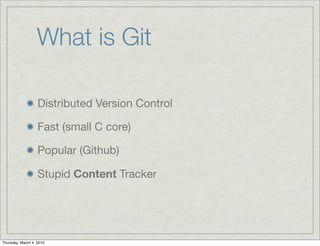Why Git
- 1. Why Git? A quick trip down the Git rabbit hole. Mark Guzman mg@hasno.info @segy http://hasno.info Thursday, March 4, 2010
- 2. What is Git Distributed Version Control Fast (small C core) Popular (Github) Stupid Content Tracker Thursday, March 4, 2010
- 3. ĩþąðēÔąðïŽtēõ Easier Merging Cheap fast branching Speed Checkout size Maintains an easily usable history Redundancy by default Thursday, March 4, 2010
- 4. Why Merging Tracking Matters History Matters Why did Bob change 10 ïŽles in his branch 3 weeks back? Why did you change some of the same ïŽles in yours? How will you know a year down the road? Thursday, March 4, 2010
- 5. File Based Change Tracking Thursday, March 4, 2010
- 6. Changeset Tracking âīGit treats all your changes as a single ChangeSet. âīIt uses a SHA-1 hash of the changes to identify them âīEg: commit 7ef55e41f1cf529e47723d869233492077c94896 Thursday, March 4, 2010
- 7. Stupid Content Tracking Simple object relationships. Tree (folder) -> Blob (ïŽle data) Thursday, March 4, 2010
- 8. Commits -> Trees Thursday, March 4, 2010
- 9. Refs (Branches) Refs -> Commits -> Trees -> Blobs Thursday, March 4, 2010
- 10. Staging The Index (Staging Area) allows you to organize Does the comment make sense for the commit? Thursday, March 4, 2010
- 11. Centralized WorkïŽow Central Repository is treated as a hub for changes. It would drive automated builds. Thursday, March 4, 2010
- 12. Distributed WorkïŽow You can pull from any compatible* source Thursday, March 4, 2010
- 13. Branch & Merge tracking Branch with changes Merged Tree Thursday, March 4, 2010
- 14. Rebase? Take my commits and replay them after the HEAD of another branch. Thursday, March 4, 2010
- 15. Windows Tools TortoiseGit Git Extensions msysgit Git Cheetah git-gui gitk Thursday, March 4, 2010
- 16. Live Demo Time. Thursday, March 4, 2010
- 17. Notes from the Trenches Learning curve Server setup easier on linux Submodules != svn externals Watch our for detached HEAD Be EXTREMELY careful with a force push. Thursday, March 4, 2010
- 18. Force things at your own risk. Thursday, March 4, 2010
- 19. Why I choose Git. Merging with history Quick branch switching Stashing and Staging Best SCM Iâve used so far. Thursday, March 4, 2010
- 20. Questions References http://git-scm.com http://github.com http://code.google.com/p/tortoisegit/ http://code.google.com/p/gitextensions/ http://marklodato.github.com/visual-git-guide/ http://progit.org/book/ http://www.timdavis.com.au/git/setting-up-a-msysgit-server-with-copssh-on- windows/ Thursday, March 4, 2010




















